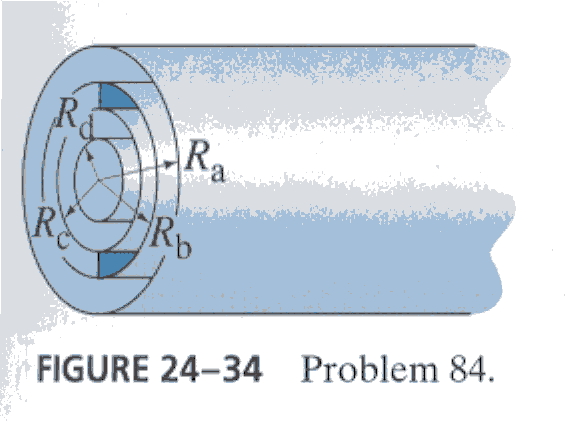
```````````````CHAPTER 24 HOMEWORK
1. (p.628 Ex.7) It takes25J of energy to move a 0.20mC charge from one plate of a 16-mF capacitor to the other. How much charge is on each plate?
2. (p.628 Ex.16) Suppose a capacitor carries a charge of + 4.2mC, and an electric field of 2.0kV/mm is desired between the plates which are separated by 4.0mm of air. What must each plate's area be?
3. (p.629 Ex.23) (a) Determine the equivalent capacitance of the circuit shown in Fig. 24-18. (b) If C1 = C2 = 2C3 =14.0mF, much charge is stored on each capacitor when V = 25.0V?
4. (p.629 Ex.30) Suppose in Fig. 24-21 that C1 = C2 = C3 = 16.0mF and C4 = 36.0mF. If the charge on C2 is Q2 = 12.4mC, determine the charge on each of the other capacitors, the voltage across each capacitor, and the voltage Vab across the entire combination.
5. (p.630 Ex.45) How much energy must a 12-V battery expend to fully charge a 0.15-mF and a 0.20mF capacitor when they are placed (a) in parallel, (b) in series? (c) How much charge flowed from the battery in each case?
6. (p.631 Ex.56 Two different dielectric each fill half the space between the plates of a parallel-plate capacitor as shown in Fig. 24-27. Determine a formula for the capacitance in terms of K1 and K2, the area A of the plates, and the separation d. [Hint: Can you consider this capacitor as two capacitors in series or in parallel?]
7*. (p.630 Ex.37) Suppose one plate of a parallel-plate capacitor were tilted so it made a small angle q with the other plate, as shown in Fig. 24-25. determine a formula for C in terms of A, d, and q , where A is the area of each plate and q is small. Assume the plates are square. [Hint: Imagine the capacitor as many infinitesimal capacitors in parallel.]

8*. (p.631 Ex.60) A slab of width d and dielectric constant K is inserted a distance x between the square parallel plates (of side l) of a capacitor as shown in fig. 24-29. determine, as a function of x, (a) the capacitance, (b) the energy stored if the potential difference is V0, and (c) the magnitude and direction of the force exerted on the slab ( assume V0 is constant).

9* (p.633 Ex.84) The long cylindrical capacitor shown in Fig. 24-34 consists of 4 concentric cylinders, with respective radii Ra, Rb, Rc, and Rd. The cylinders b and c are joined by metal strips, as indicated. Determine the capacitance per unit length of this arrangement.
